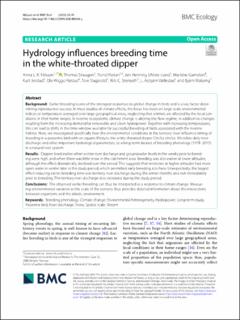| dc.description.abstract | Background: Earlier breeding is one of the strongest responses to global change in birds and is a key factor determining reproductive success. In most studies of climate effects, the focus has been on large-scale environmental indices or temperature averaged over large geographical areas, neglecting that animals are affected by the local conditions in their home ranges. In riverine ecosystems, climate change is altering the flow regime, in addition to changes resulting from the increasing demand for renewable and clean hydropower. Together with increasing temperatures, this can lead to shifts in the time window available for successful breeding of birds associated with the riverine habitat. Here, we investigated specifically how the environmental conditions at the territory level influence timing of breeding in a passerine bird with an aquatic lifestyle, the white-throated dipper Cinclus cinclus. We relate daily river discharge and other important hydrological parameters, to a long-term dataset of breeding phenology (1978–2015) in a natural river system. Results: Dippers bred earlier when winter river discharge and groundwater levels in the weeks prior to breeding were high, and when there was little snow in the catchment area. Breeding was also earlier at lower altitudes, although the effect dramatically declined over the period. This suggests that territories at higher altitudes had more open water in winter later in the study period, which permitted early breeding also here. Unexpectedly, the largest effect inducing earlier breeding time was territory river discharge during the winter months and not immediately prior to breeding. The territory river discharge also increased during the study period. Conclusions: The observed earlier breeding can thus be interpreted as a response to climate change. Measuring environmental variation at the scale of the territory thus provides detailed information about the interactions between organisms and the abiotic environment. Breeding phenology, Climate change, Environmental heterogeneity, Hydropower, Long-term study, Passerine bird, River discharge, Snow, Spatial scale, Stream | |
